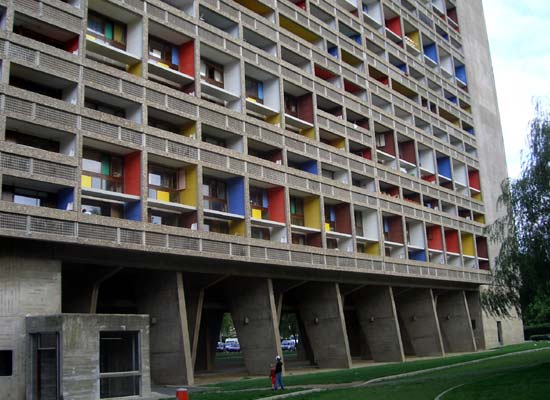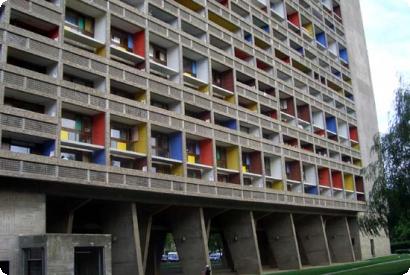Please wait a few moments while we process your request

Siraj Izhar and ECOS
ecosXchange
ecosXchange is a collaborative development between ECOS and artist Siraj Izhar, together with multimedia artist Dominique Leroy and environmental engineer/ecologist Benjamin Larcher.
Partially funded by the Foundation, ecosXchange is an immaterial work of art in the form of a social participation currency - a type of 'money' – that acts as a new economic and cultural dimension within a community. The 'ecosXchange' currency aims to create a system of exchange value between cultural production and ecological process.
The ecosXchange prototype has been devised for the residents of Maison Radieuse, a 1950s Le Corbusier Unité D'Habitation building in Rezé, a suburb of Nantes (France). Le Corbusier’s Unité was the original modernist model of a high-density high-rise habitat, with 14 square metres of living space allocated per person. Today, the Maison Radieuse houses 1000 residents, consists of 290 apartments, and is home to two architectural agencies, one journalism agency, and two associations (ECOS and Association des Habitants de la Maison Radieuse).
ecosXchange’s artistic challenge is to integrate itself into the cultural life of Maison Radieuse residents by changing consumption patterns. It will attempt to reduce the collective ecological footprint (1) of high-density living through social participation. Based on whole-life economics, ecosXchange’s technical approach takes into account the residents’ living conditions and consumption patterns (e.g. waste reduction, introduction of sustainable and/or more efficient energy, etc.), and their everyday activities (transport, use of common spaces, such as the park, etc.).
ecosXchange has five functions (2):
1) It is a means of measuring the ecological footprint of any given community (in this case, the Maison Radieuse);
2) It is a tool for organically increasing participation by ordinary people in the social processes that reduce the ecological footprint of a community;
3) It is a tool for reducing the ecological footprint in an intelligent generational way – what is useful in one cycle can change as the values of measuring the ecological footprint are refined through time. This idea of progressive evolution is a key component of ecosXchange;
4) It is a way of capitalizing ecological processes by transforming them into shareable assets and exchangeable resources so that new ecosXchange generations can become an integral part of the cultural life of the community.
5) It is a means of inter-relating disparate social activities by bringing them into a scheme of collectively created shared values and converting invisible costs to visible costs so that they can in turn play a role in ecological awareness.
Economics advisors will evaluate all social communal activities so that the tangible energy (and financial savings) made in the running of Maison Radieuse are valued and properly capitalised to underwrite ecosXchange as a complementary currency. This will in turn set up the scale of values for software programmers to develop applications for residents’ use. The workings, trackings and findings of ecosXchange will be visualised and accessible through a Web site (3), with each participating resident having his or her own account. The software program will collect data on residents’ activities by crediting or debiting their ecosXchange account.
Partially funded by the Foundation, ecosXchange is an immaterial work of art in the form of a social participation currency - a type of 'money' – that acts as a new economic and cultural dimension within a community. The 'ecosXchange' currency aims to create a system of exchange value between cultural production and ecological process.
The ecosXchange prototype has been devised for the residents of Maison Radieuse, a 1950s Le Corbusier Unité D'Habitation building in Rezé, a suburb of Nantes (France). Le Corbusier’s Unité was the original modernist model of a high-density high-rise habitat, with 14 square metres of living space allocated per person. Today, the Maison Radieuse houses 1000 residents, consists of 290 apartments, and is home to two architectural agencies, one journalism agency, and two associations (ECOS and Association des Habitants de la Maison Radieuse).
ecosXchange’s artistic challenge is to integrate itself into the cultural life of Maison Radieuse residents by changing consumption patterns. It will attempt to reduce the collective ecological footprint (1) of high-density living through social participation. Based on whole-life economics, ecosXchange’s technical approach takes into account the residents’ living conditions and consumption patterns (e.g. waste reduction, introduction of sustainable and/or more efficient energy, etc.), and their everyday activities (transport, use of common spaces, such as the park, etc.).
ecosXchange has five functions (2):
1) It is a means of measuring the ecological footprint of any given community (in this case, the Maison Radieuse);
2) It is a tool for organically increasing participation by ordinary people in the social processes that reduce the ecological footprint of a community;
3) It is a tool for reducing the ecological footprint in an intelligent generational way – what is useful in one cycle can change as the values of measuring the ecological footprint are refined through time. This idea of progressive evolution is a key component of ecosXchange;
4) It is a way of capitalizing ecological processes by transforming them into shareable assets and exchangeable resources so that new ecosXchange generations can become an integral part of the cultural life of the community.
5) It is a means of inter-relating disparate social activities by bringing them into a scheme of collectively created shared values and converting invisible costs to visible costs so that they can in turn play a role in ecological awareness.
Economics advisors will evaluate all social communal activities so that the tangible energy (and financial savings) made in the running of Maison Radieuse are valued and properly capitalised to underwrite ecosXchange as a complementary currency. This will in turn set up the scale of values for software programmers to develop applications for residents’ use. The workings, trackings and findings of ecosXchange will be visualised and accessible through a Web site (3), with each participating resident having his or her own account. The software program will collect data on residents’ activities by crediting or debiting their ecosXchange account.
© 2007 FDL
(1) Ecological footprint analysis attempts to measure the human demand on nature and compares human consumption of natural resources with the earth's ecological capacity to regenerate them. It is an estimate of the amount of land area a human population, given prevailing technology, would need if the current resource consumption and pollution by the population is matched by the sustainable (renewable) resource production and waste assimilation by such a land area.
(2) Quoted from Siraj Izhar's proposal.
Related page:
 ECOS, Siraj Izhar, Dominique Leroy & Benjamin Larcher
ECOS, Siraj Izhar, Dominique Leroy & Benjamin LarcherIzhar is a London artist, writer and social activist.
External links:
ecosXchange:
http://www.xyzlondon.com/ecosXchange.html
http://www.xyzlondon.com/ecosXchange.html
Peconome Banque Sociale:
https://www.peconome.org/
https://www.peconome.org/



